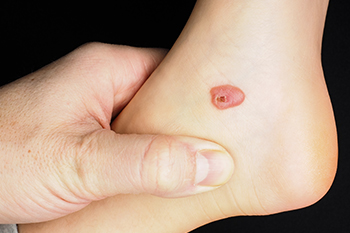
Blood blisters and regular blisters both form in response to friction, but they differ in appearance and severity. A regular blister is filled with clear fluid and typically forms when skin rubs against something repeatedly, causing the outer layer of skin to separate. Blood blisters, on the other hand, occur when a blood vessel beneath the skin breaks, causing the blister to fill with blood rather than fluid. This can also indicate that the blister is infected. Blood blisters can feel more painful, as they put pressure on the surrounding tissue. Both types of blisters can cause discomfort, swelling, and redness. It is important to keep both clean and covered to avoid further friction. Do not pop the blister as that can increase the risk of further infection. If a blood blister does not heal, a podiatrist can safely drain it, provide wound care, and advise on prevention strategies. For persistent or painful blisters, it is suggested that you schedule an appointment with a podiatrist to ensure proper care.
Blisters are prone to making everyday activities extremely uncomfortable. If your feet are hurting, contact one of our podiatrists of Kokomo Foot & Ankle Center. Our doctors can provide the care you need to keep you pain-free and on your feet.
Foot Blisters
Foot blisters develop as a result of constantly wearing tight or ill-fitting footwear. This happens due to the constant rubbing from the shoe, which can often lead to pain.
What Are Foot Blisters?
A foot blister is a small fluid-filled pocket that forms on the upper-most layer of the skin. Blisters are filled with clear fluid and can lead to blood drainage or pus if the area becomes infected.
How Do Blisters Form?
Blisters on the feet are often the result of constant friction of skin and material, usually by shoe rubbing. Walking in sandals, boots, or shoes that don’t fit properly for long periods of time can result in a blister. Having consistent foot moisture and humidity can easily lead to blister formation.
Prevention & Treatment
It is important to properly care for the affected area in order to prevent infection and ease the pain. Do not lance the blister and use a Band-Aid to provide pain relief. Also, be sure to keep your feet dry and wear proper fitting shoes. If you see blood or pus in a blister, seek assistance from a podiatrist.
If you have any questions, please feel free to contact our office located in Contact Us . We offer the newest diagnostic and treatment technologies for all your foot care needs.
